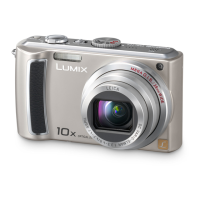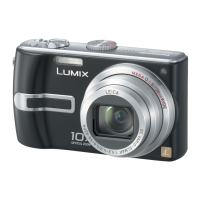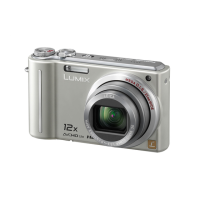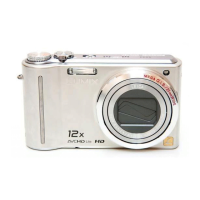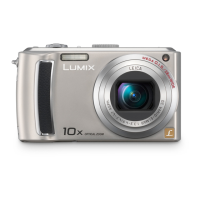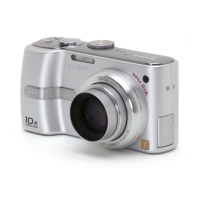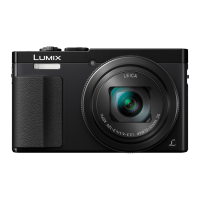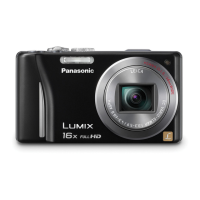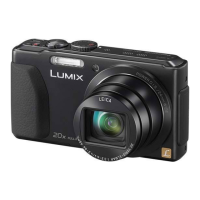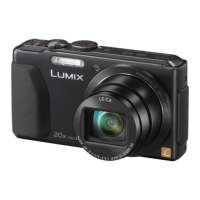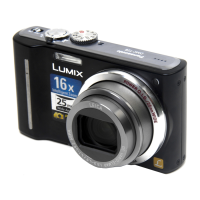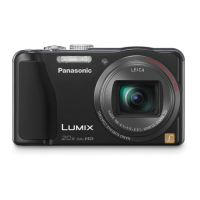
Do you have a question about the Panasonic Lumix DMC-TZ8 and is the answer not in the manual?
| Brand | Panasonic |
|---|---|
| Model | Lumix DMC-TZ8 |
| Category | Digital Camera |
| Language | English |
Step-by-step instructions for charging the camera's battery before first use.
How to properly insert the battery pack and memory card into the camera.
Basic procedure to power on the camera and initialize it.
Instructions for setting the switch to the correct position for recording or playback.
Guide to setting the mode dial to the automatic shooting mode.
The final step in the quick start guide to capture images.
Simple steps to review captured still and motion pictures.
Recommendation to perform a test shot to ensure camera functionality before critical use.
Guidelines to avoid physical damage, operational errors, and product faults.
Instructions for cleaning and handling the camera lens to maintain image quality.
Information on compatible batteries and warnings about counterfeit products.
Instructions for connecting the battery to the charger.
How to plug the battery charger into a power source.
Initial step to access the card and battery compartment.
Correct procedure for inserting the battery and memory card.
How to use an optional DC coupler for continuous power.
Overview of the different menu categories available in the camera.
Menu for adjusting picture and recording settings.
Menu for general camera settings like clock and sound.
Setting the camera's date, time, and display format.
Adjusting or muting camera beep and shutter sounds.
Controlling the camera's speaker volume.
Registering and recalling custom camera settings.
Verifying the recordable area for motion pictures before recording.
Conserving battery by dimming the LCD or shutting off power automatically.
Automatically shutting off the camera's power after a period of inactivity.
Resetting camera settings to their default values.
Selecting the communication mode when connecting to a computer or printer.
Configuring HDMI output resolution for high-definition TVs.
Using the camera's intelligent auto mode for optimal settings.
How the camera automatically identifies scenes for optimal settings.
How the camera identifies and processes human faces for better shots.
How to keep a moving subject in focus by tracking its movement.
Using program AE mode to adjust settings for personal shooting preferences.
How to use optical, i.ZOOM, and digital zoom features for magnification.
Navigating through captured still and motion pictures.
Using zoom during playback to magnify parts of a picture.
Viewing pictures in a list or calendar format for easy browsing.
Methods for removing unwanted pictures from the camera.
Efficiently deleting a batch of pictures or all pictures.
Understanding histograms for exposure analysis.
Using on-screen guide lines for composition assistance.
Accessing flash settings to choose shooting modes.
Choosing the appropriate flash mode for the shooting situation.
Accessing macro mode for close-up photography.
Enabling autofocus for macro shots.
Using tele macro for enhanced close-up shots with background blur.
Accessing the self-timer settings.
Choosing the delay time for the self-timer.
Accessing exposure compensation settings.
Adjusting the exposure compensation value for brighter or darker images.
Accessing the auto bracketing function.
Choosing exposure increment values for bracketing.
Enabling the multi aspect shooting feature.
Selecting aperture-priority mode for depth of field control.
Adjusting aperture settings to control depth of field.
Selecting shutter-priority mode to control motion blur.
Adjusting shutter speed to control motion blur and exposure.
Selecting manual exposure mode for full control over aperture and shutter speed.
Manually setting aperture and shutter speed for precise exposure control.
Choosing a shooting mode to save as a custom setting.
Accessing the custom memory settings menu.
Choosing which custom set slot to use for saving.
Selecting the custom mode to recall saved settings.
Choosing which custom set to activate.
Selecting the scene mode for automatic adjustments based on the environment.
Choosing a specific scene mode from the available options.
Scene mode for capturing flattering portraits.
Scene mode to smooth skin tones for portraits.
Scene mode to alter subject appearance by stretching length or width.
Scene mode for taking self-portraits.
Scene mode for capturing portraits in low light with flash.
Scene mode for clear pictures of night scenes without flash.
Scene mode for capturing natural-looking food photography.
Scene mode for bright indoor event photography.
Scene mode to capture the ambiance of candlelit settings.
Scene mode for capturing babies, with options to record age and name.
Scene mode for preventing blur in dark, indoor conditions.
Scene mode for capturing rapid movement or decisive moments.
Scene mode for continuous flash shooting in dim locations.
Scene mode for capturing clear starry skies or dark subjects.
Scene mode for capturing clear fireworks photos.
Scene mode for clear blue skies and sea without subject darkening.
Scene mode for natural snow colors in snowy scenes.
Scene mode to reduce over/underexposure in backlit or night scenes.
Selecting the appropriate format for motion picture recording.
Recording motion pictures using PASM modes for manual control.
Estimated recording times for various settings on a 2GB SD card.
Accessing recording settings via the REC menu.
Selecting the desired picture quality for motion pictures.
How the camera recognizes and processes registered faces.
Adding people's facial information for recognition by the camera.
Troubleshooting tips for recognition issues.
Accessing the face recognition settings from the REC menu.
The process of capturing a face picture for registration.
Procedures for modifying or removing registered personal data.
Explanation of Global Positioning System and its use in the camera.
How the camera utilizes GPS for location recording and time synchronization.
Editing or selecting location names for recorded pictures.
Recording the date of travel for each picture.
Setting the destination name for geotagging pictures.
Synchronizing the camera's clock with the local time at the destination.
Selecting the image quality setting for still pictures.
Adjusting the aspect ratio of pictures for printing or display.
Manually setting the ISO sensitivity for controlling light sensitivity.
Adjusting white balance to ensure accurate color reproduction under different lighting.
Managing face recognition settings and registered faces.
Selecting the autofocus mode for precise focusing.
Automatically adjusting contrast and exposure for lifelike colors.
Setting a minimum shutter speed to allow for brighter pictures in low light.
Capturing a rapid sequence of still pictures by holding the shutter button.
Magnifying images beyond optical zoom limits, potentially reducing quality.
Preventing blur by stabilizing the image during shooting.
Recording sounds along with pictures for memos or conversations.
Using the AF assist lamp to aid focusing in dark conditions.
Automatically detecting and correcting red-eye in flash photos.
Selecting the desired picture quality for motion pictures.
Steps for capturing quick memo-style pictures.
Feature for enlarging and saving parts of maps or pictures.
Accessing frequently used settings via the quick menu.
Inputting characters by selecting them and confirming.
Choosing a specific playback mode like Normal, Slide Show, etc.
Standard playback mode for viewing all pictures.
Automatically playing pictures in sequence with music and effects.
Viewing pictures based on recorded location data and landmarks.
Playing back pictures recorded during a set travel date or destination.
Classifying and viewing pictures by category, including face recognition.
Extracting still images from recorded motion picture scenes.
Dividing motion pictures into segments for easier management.
Choosing the type of content to play in a slideshow.
Customizing music and transition effects for slideshows.
Choosing the type of media (still, AVCHD Lite, Motion JPEG) for playback.
Viewing pictures based on recorded location data and landmarks.
Choosing a specific location to view associated pictures.
Viewing pictures organized by date in a calendar format.
Adding titles to favorite still pictures.
Splitting motion pictures into smaller segments.
Adding text, date, and location information to pictures.
Choosing which information to stamp onto pictures.
Resizing a single picture.
Choosing the target picture size after resizing.
Resizing multiple pictures simultaneously.
Selecting a picture to crop.
Defining the area of the picture to be cropped.
Selecting a picture to level.
Correcting slight tilts or slants in pictures.
Converting picture aspect ratios for printing or compatibility.
Marking favorite pictures for easier organization and playback.
Configuring print settings for PictBridge-compatible printers or shops.
Protecting pictures from accidental deletion.
Editing or deleting mistaken face recognition data.
Copying pictures between the camera's built-in memory and a memory card.
Transferring video via AV cables to other recording devices.
Using software to transfer and manage media on a computer.
Steps for copying media files to a computer.
Establishing the physical connection between camera and PC.
Setting the camera's USB mode to PC connection.
Establishing the physical connection between camera and printer.
Setting the camera's USB mode to PictBridge.
Initiating the printing process.
Selecting and printing multiple pictures at once.
Printing pictures with embedded text and date information.
Configuring print options like paper size, number of copies, and date printing.
Establishing the physical connection between camera and TV.
Setting the REC/PLAY switch for playback.
High-resolution viewing using an HDMI connection.
Linking camera operations with compatible Panasonic TVs using HDMI.
Navigating and selecting pictures for TV viewing.
Changing playback modes while viewing on TV.
Icons and indicators displayed on the LCD during recording.
Icons and indicators displayed on the LCD during playback.
Error message for incompatible memory cards.
Error message when memory card write protection is active.
Error message indicating insufficient storage space.
Error related to the memory card, prompting for formatting.
Errors related to reading or writing data on the memory card.
Message indicating an incompatible or unrecognized battery.
Troubleshooting common power and battery-related issues.
Solutions for problems encountered during picture and video recording.
Troubleshooting issues related to the camera's flash.
Solutions for problems encountered during picture playback.
Solutions for recording problems like brightness or motion picture stopping.
Reasons and solutions for motion picture recording interruptions.
Troubleshooting issues related to the LCD monitor display.
Troubleshooting issues related to TV, computer, and printer connectivity.
Troubleshooting VIERA Link HDMI connectivity issues.
Problems preventing picture transfer to a computer.
Solutions for miscellaneous camera issues.
Important guidelines for camera usage, care, and safety.
Important precautions and guidelines for using the camera.
Instructions for cleaning and maintaining the camera.
Precautions and guidelines for handling memory cards and data.
Handling personal data stored in the camera and privacy considerations.
Terms and conditions for using location data features.
